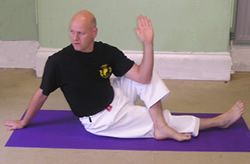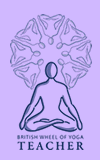On the surface, Yoga and Martial Arts seem to have little in common – very different disaplines and philosophies. But look a little deeper and it becomes evident that they are very much linked to each other.
Most of the Asian martial arts, seemed to have originated from the Shaolin Temple in Hunan Province, China. The monks at the temple had developed excellent meditation techniques, but they lacked a physical health system to develop their bodies. A visiting Buddist monk from India, named Boddidharma, arrived by invitation in the 6
th century AD to teach a physical system known as Yoga.
Boddidharma was thought to be a member of the Warrior Caste (a form of military that protected the ruling classes of the day). He would have had knowledge and skills of an Indian martial art of
Kalarippyat, ‘Kalari’ means school or art, ‘payat’ means skill training, exercise or practice.
Not many martial artists realise the healing powers of Yoga, due mainly to misconceptions. However, the sports and fitness industries are beginning to recognise the therapeutic value of yoga
asanas (postures) and
pranayama (breathing). Postures can be used to supplement martial arts training, and be used to prevent injuries and speed up recovery.
I have personally benefited from the practice of Hatha Yoga. After years of training I was suffering from back and knee problems. I even resigned myself to the possibility of ending my Karate training. Regular trips to the Chiropractor seemed the only answer, until I discovered a local Yoga class. With correct instruction from a qualified Yoga Instructor who ensures you are in a correct and safe position, you cannot go wrong.

I fully recommend Yoga to any martial artist. No matter what martial art you practice, their will be a tendency to favour one side of the body which is considered to be the stronger side. In Karate and other punching and kicking arts, more time seems to be spent on an already stronger side, which results in even more imbalance in the body.
If a person for example, prefers to kick from the right leg, he/she will have stronger yet less flexible hip flexors on the right side than on the left side. The right hip flexors will then pull on the lower back and hip, which then brings the whole pelvic area out of balance. If this person starts to use the appropriate Yoga asana routine, the weaker side will get stronger and the stronger side will get more flexible, without losing their respective strength and flexibility. This brings the pelvis back to its neutral and balanced state.
Yoga asanas are ideal for simultaneously training and developing flexibility and strength.
Instead of doing strength and flexibility training separately, one can do both at the same time. By including Yoga in their training, martial artists will become more flexible, stronger, focused, helping to become better at their martial art.

Over time, many hours of training and competing might lead to injuries of the neck, shoulders, hips, back and knees. Regular Yoga practice could prevent this. One of Patanjali’s aphorisms states, ‘Heyham dukham anagatam’, ‘the pains that are yet to come can and are to be avoided’.
The many advantages and benefits of regular Yoga regardless of martial art style include:
• Helping to prevent injury as well as aiding recovery
• Improving flexibility through the whole body
• Increasing core strength and stability
• Increasing lung capacity and endurance through breathing exercises
• Learning how to relax
• Reducing tension
• Improving balance from asana
• Healing the body after intense workouts
• Loosing tight muscles
Article submitted by Ian Gellatly, for further information e-mail iangellatly@fsmail.net.
Ian has been regularly practising Yoga with Janet Evans since May 2006.
This article was published in Yoga and Health magazine spring 2007.


